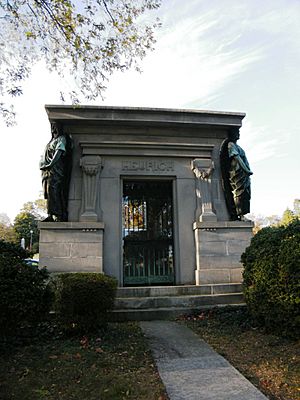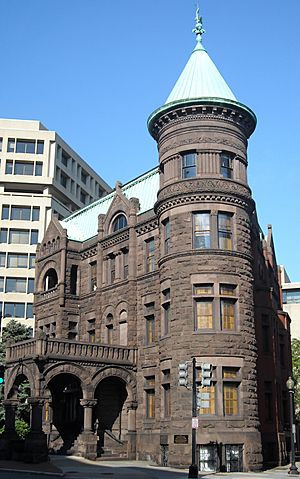Heurich Mausoleum facts for kids
Quick facts for kids Heurich Mausoleum |
|
|---|---|
 |
|
| Artist | Louis Amateis |
| Year | ca. 1895 |
| Type | Bronze & Granite |
| Dimensions | 240 cm × 110 cm × 70 cm (96 in × 43.2 in × 27.6 in) |
| Location | Washington, D.C., United States |
| 38°56′46.95″N 77°0′40.7″W / 38.9463750°N 77.011306°W | |
| Owner | Rock Creek Cemetery |
The Heurich Mausoleum is a special artwork created by the sculptor Louis Amateis. You can find it at Rock Creek Cemetery in Washington, D.C., United States. This beautiful sculpture was looked at in 1993 as part of the Smithsonian's "Save Outdoor Sculpture!" project. It is the final resting place for members of the Heurich family.
Contents
What Does the Heurich Mausoleum Look Like?
This artwork is a large granite mausoleum, which is like a fancy building for burials. It measures about 15 by 22 by 16 feet. On each corner, there are four special statues called caryatids. A caryatid is a sculpted female figure that acts like a column.
These four figures have wings and stand with their hands together. Their eyes are closed, and their heads touch the roof of the mausoleum. Their bare feet rest on a low ledge. Two of the figures have braided hair, one has long hair over her shoulders, and the last one has a cape around her head.
On the back of the mausoleum, there is a stained glass window. It shows an angel holding a scroll with the word "Peace" written on it.
You can see the artist's name, "L. AMATEIS," and "Gorham MFG CO Founders" signed on the caryatids. Above the mausoleum door, it simply says: "HEURICH".
Inside, on the wall, there's a German message:
- In Tiefem
- Schmerz Kein
- Weltweisheit
- Fürs Herz
This means: "In Deep Pain, (There is) no Worldly Wisdom for the Heart."
Who Was Louis Amateis?
Louis Amateis was born in Turin, Italy, on December 13, 1855. He studied architecture and sculpture in Italy and France. In 1883, he moved to New York City.
He worked as an architectural sculptor and got married in 1889. Later, he and his family moved to Washington, D.C. There, he started the School of Architecture and Fine Arts at what is now George Washington University. He was the head of this school from 1892 to 1902. Louis Amateis passed away suddenly on March 18, 1913. His son, Edmond Amateis, also became a famous sculptor.
Amateis created many important works. Some of his designs can be seen at the United States Capitol. He also made busts (sculptures of heads and shoulders) of famous people like Chester A. Arthur and Andrew Carnegie.
How Did the Mausoleum Get Here?
The Heurich family mausoleum was not always at Rock Creek Cemetery. It was first located on their family dairy farm in Prince George's County, Maryland. This farm was in an area where a large shopping mall, now called the Mall at Prince Georges, was later built.
In 1951, Mrs. Heurich, Christian Heurich's third wife, sold the farm. That's when the mausoleum was moved to its current location at Rock Creek Cemetery.
The Heurich Family Story
The Heurich Mausoleum is where members of the Heurich family are buried. Christian Heurich (1842–1945) came to the United States from Germany in 1866.
In 1872, he started the Christian Heurich Brewing Company in Washington, D.C. A brewery is a place where beer is made. His first brewery was in Dupont Circle. In 1895, he moved it to a much bigger place near where the Theodore Roosevelt Bridge and the Kennedy Center are today. The brewery closed in 1956.
The Heurich family lived in a grand house in Dupont Circle. It is known today as the Brewmaster's Castle. The beautiful stained glass window inside the mausoleum was designed by the famous artist Louis Comfort Tiffany.
Taking Care of the Mausoleum
In 1993, experts checked the condition of this sculpture. They noted that it needed some care and treatment to keep it looking its best.








